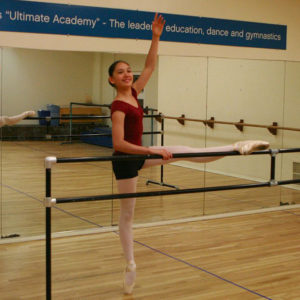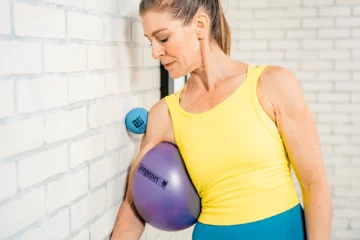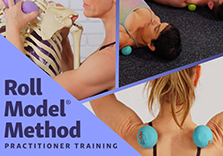
Like many others, for many years yoga has been my haven. I came to yoga as a gentle practice after years of competitive, high-impact sports had left my body a wreck. As the years went on and I picked up the pace and frequency of my practice, the repetitive movement of my beloved vinyasa classes began to take its toll. After I sprained both of my shoulders, I decided to take a break from my yoga practice and pursue different modalities. This pursuit brought me into my first barre class.
I was hesitant at first to head to a barre class, as I knew nothing of dance (other than what I saw on TV) and feared my unstable knees could pose a problem. I found the class to be very accessible and the instructors were highly receptive to the different needs in the room.

Much like yoga, barre provided many levels of difficulty and optional layering so the class was accessible to my, at the time, injured body. As with any modality, as my participation frequency increased, familiar patterns of wear and tear began to arise, which led me to come up with a few ideas for tuning up before and after any barre class. As most of the barre classes I have attended focus a large portion of the class on the legs and glutes, my tune ups focus on the lower body (mostly).
I will, however, start with the commonly heard “belly button to spine” or “hollow out your core”. These phrases come up across the board of modalities and are said, I like to think, with the best of intentions. What I think we are really looking for here is a bracing, or tubularizing of the core, as we like to say in Yoga Tune Up®. Activating the entirety of the midsection (abdominals and low back) allows for a stable and happy spine during a barre practice, helping to keep the lower ribs hugged in and the pelvis in a neutral position. This makes for a happy low back with no pain after class. If you have problems keeping your low ribs from thrusting out as you come into various postures, practice intercostal crunches to help strengthen your ‘rib hugging’ muscles. (Read fellow YTU teacher Dagmar Khan’s article, Confessions Of A Chronic Rib Thruster, to learn more about rib thrusting and why it is not ideal for your body.)
Once you have your core engaged and properly secured, you can now focus on ensuring your lower body is aligned as well. Most barre classes require you to frequently be externally rotated while squatting on and/or off your toes (known as plies). As you come into varying levels of external rotation with hip flexion, your hips cannot create the proper amount of torque needed to allow the soft tissues of the lower body to support you properly as you squat, which can lead to hip, knee, and back issues if not properly maintained. Squatting with extreme amounts of external rotation also requires a ton of pelvis and rib control to prevent over extension in the low back through rib thrusting and anterior tilting of the pelvis. To counteract the pelvic tilt, you may hear your instructor tell you to “tuck your tailbone” or “tuck under”, to realign the pelvis under the spinal column.
Sadly, for my body, these types of poses are simply not obtainable. Many of the externally rotated squat postures are just too much for my hips and knees, so I modify with feet flat and parallel. I have never had an instructor say anything but positive remarks about me modifying the poses to fit my needs. If a pose is not working for you don’t be afraid to adapt it to fit. Remember, adapting a pose to fit your body is not the same as doing the ‘wrong’ pose or doing the pose incorrectly. Any athletic practice should be about finding the right positions for your body. You are always in charge of your health and your body’s needs.
Come back on Friday to learn my favorite Yoga Tune Up® poses to incorporate before or after your barre class!
Learn more about Post-Athletic stretching.











Love reading about this since I love Barre and love teaching Barre. Thanks for the Barre Tune Up!
I, too, have found barre classes a great complement to my yoga practice. The focus on strengthening the muscles around the joints has been invaluable to keep my very mobile body feeling strong and stable. I also choose variations that may differ from the group to honor what I know my body needs. Thanks for sharing your experience! I recommend barre classes to anyone who wants to diversify their movement practice.
“If a pose is not working for you don’t be afraid to adapt it to fit.” THANK YOU for this! I’ve worked hard to overcome that Type-A people-pleasing teacher-is-never-wrong mentality, and Yoga Tune Up® is a whole toolbox of figuring out how to make poses work for me.
Thanks for this! I’ve been intrigued by barre classes for some time now, and while there are no classes in my small town, I’m always tempted to try one when visiting bigger cities. I’m looking even more forward to trying one now, especially equipped with my YTU lens.
“If a pose is not working for you don’t be afraid to adapt it to fit”…such a great thing to keep in mind in any new movement practice!
Thanks for your post! I teach YTU and take barre and modify by keeping my feet parralell/ not externally rotating my hips during squats. But I always wonder why the teacher in the class says “knees in the same direction as toes to protect the knees”.
I am so glad to read of your modification re: doing squat in parallel. I made this adjustment after a knee injury last summer and I felt like it worked so much better for my body. Thanks!
wonderful article! I am both a yoga and a barre instructor so this serves as a wonderful reminder to me to keep movements as varied as possible within the choreography allowed. AND to be more mindful of offering modifications for those, like you, that simply may have difficulty accessing external rotations. thank you!
Totally agree with you…make the poses work to your body in a safe and effective way!
I’ve been meaning to take a barre class since I saw it advertisted at my YogaWorks studio and reading this makes me especially eager to because I realize how I will be able to integrate my Yoga Tune Up embodiment into that experience.
Kevyn – For me, the most compelling point you make in this article is the sentence in which you say, “If a pose is not working for you don’t be afraid to adapt it to fit.” So often, it seems, that is exactly the opposite of what most of us do, right? Typically, we strive to “fit” ourselves into a pose which creates the potential for injury. It can be a challenge for us to let go of ego, go against the grain, or gracefully accept our body’s limitations and adjust accordingly, as you did with your foot position. Thank you for the reminder that it’s ok, nay, even healthy, to meet our body at it’s point of need and modify as needed!
I have been wanting to try a barre class and this article is very helpful regarding how I can integrate my practice or self-knowledge into the practice so as to honor my body’s capabilities.
I’m realizing more and more how important preparation, alignment and cool down is for a great workout with minimal “side affects. Yoga Tune-Up is a a great system that applies across multiple disciplines
The concept of supporting the spine, as is done when tubularizing the core, to enhance efficiency and effectiveness when moving the limbs seems to be missed in modern day human movement. Many of my clients and students associate moving their arms and legs with the strength and flexibility of just these parts of the body. It is often an ‘ah-ha’ moment for them when they realize that core stability reduces the effort necessary to move their whole body! When the core is supported, it allows for the recruitment of the appropriate muscles without needing to engage muscles to compensate for an unstable spine. Tubularizing the core and practicing other core stabilizing Yoga Tune Up® exercises is a great way to Tune Up Barre class and any other sport or physical practice.Thanks for the great post!